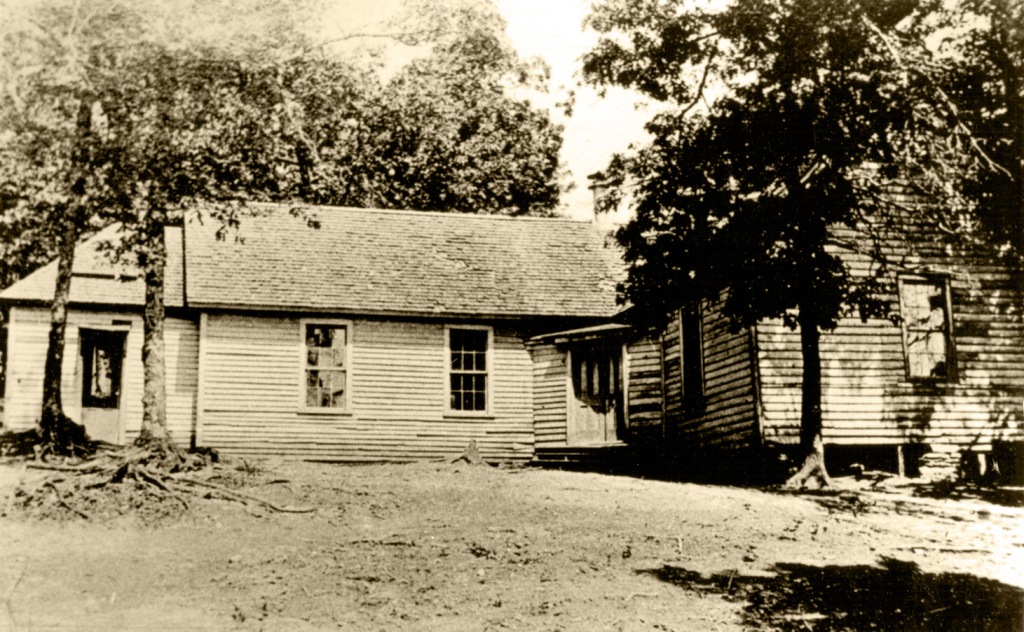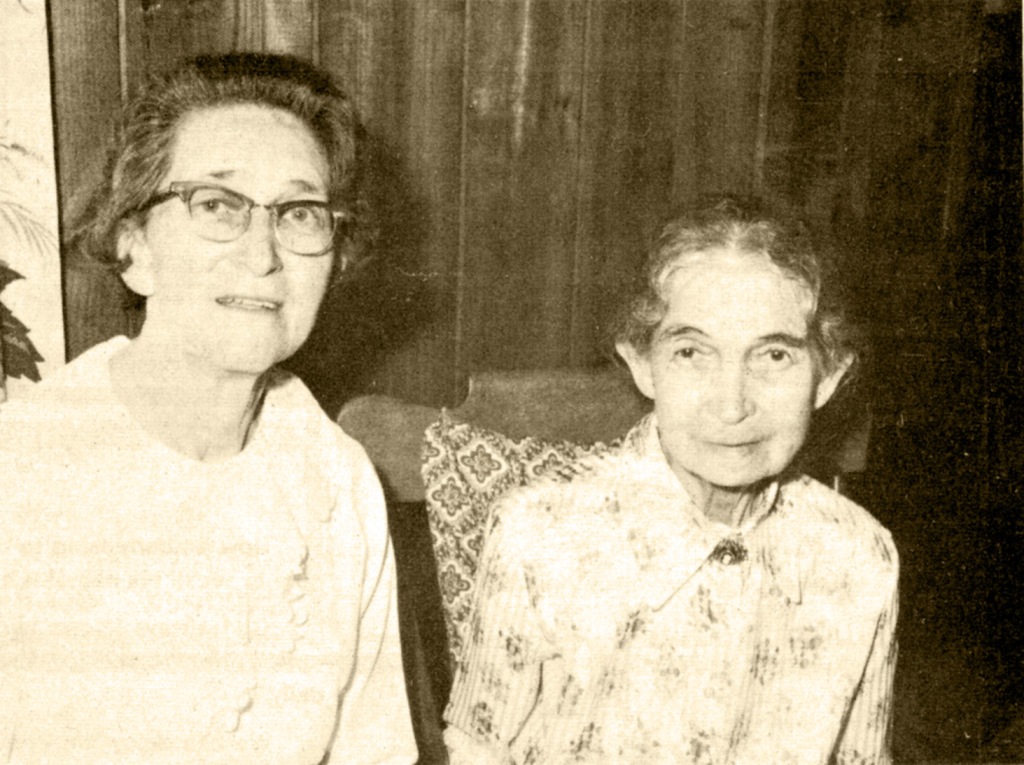By Guest Contributor Randolph Shaffner

Randolph Shaffner, a former president of the Hudson Library Board of Trustees, is the author of Good Reading Material, Mostly Bound and New: The Hudson Library 1884-1994, which is available for purchase at the library, all proceeds benefiting the library. He currently serves as archivist for the Highlands Historical Society, his publications being listed at https://ranshaffner.com.
As the Fontana Regional Library celebrates its 75th Anniversary, the Hudson Library of Highlands, as a part of the regional library system, celebrates its 135th Anniversary as the second oldest public library in the state.[1]

It was born in 1880 in several boxes of very fine books brought up the mountain by covered wagon from Seneca, S.C., en route from Worcester, Massachusetts. These eighty books were donated in loving memory of Ella Emmons Hudson, whose dream to provide good reading material for the little communities on the Highlands plateau they would fulfill, unfortunately after her death.
The little library operated from an enclosed bookcase in a corner of the main room of the first schoolhouse. The public had access to the books twice a week, on Friday evening and Saturday afternoon. Their librarian, Miss Laura “Kittie” Kibbee, was a 19-year-old physician’s daughter, who taught school during the week.

In 1884, when the library established itself officially as the Hudson Free Library Association, its trustees sat in clumsy, handmade wooden desks intended for school children to be most uncomfortable. Its newly elected officers were the founder of the town, the postmaster, a doctor, and a sash-and-door merchant.
The population of the town stood at 300 permanent residents hailing from 22 states, a truly cosmopolitan mixture to support a local library in what would be promoted as “the highest incorporated town east of the Rocky Mountains.”[2]
In 1894, when the principal of the school, Professor Harbison, retired and donated to the Hudson Library the annex he had built for his own library, the enclosed bookcase moved into its own small room. The addition of Harbison’s library, which was extensive with more than 1,000 books, gave the new library in its new home the distinction of being “the best school library in Western North Carolina.”[3]
Like a conch that has outgrown its shell, the library suddenly found room to expand, absorbing many books now donated to its fast-growing collection. A stove, which was cracked but repaired on one side, was loaned to the Association, along with a donated cord of wood, a lamp, and a table for a comfortable setting in its new environment.
By 1895 the Hudson Free Library had enough books in its cozy room to consider owning real estate, so it incorporated and appointed Miss Albertina Staub, age twenty-nine, who looked like her name, short, prim, and precise, as its librarian, serving two hours a week at “the munificent salary of $10.00 a year.”[4]
With donations on the increase in a newly incorporated association, Mary Chapin Smith was given the task of culling out the “cheap trash” that people wanted to discard by “dumping” it on the library. Consequently, the book committee became heavily engaged in literary censorship, “sifting the books, rejecting the absolutely harmful and vulgar, and also freeing the shelves from much that was not only antiquated but valueless.”[5]
After 1898 the library opened twice a week, thrice a week during the summer. Summer visitors were now charged fees to keep the library free for year-round residents, as Ella Hudson had originally intended. The summer visitors considered this change to be fair, readily contributing six to eighteen dollars during the next three summers.
Having been taught the difference between good books and cheap trash, donors now contributed the latest works by subsequently famous American authors like Louisa May Alcott, Mark Twain, Rudyard Kipling, Andrew Lang, and Joel Chandler Harris, including monthly installments of their works in the popular St. Nicholas Magazine.
By 1904, with the town’s population now at 450, the number of volumes in the Hudson Library had increased to 800 titles, cataloged for the first time in sixteen categories. The association relied almost entirely for support on membership fees, fines, seasonal and monthly subscriptions, and small contributions for income, including the rent shelf, none of which was hardly enough.
Among the most sought-after books on the library’s shelves, particularly among the children, was The Five Little Peppers. Like the book’s theme of growth from poverty, the library too weathered hard times enough to purchase a lot in 1911 for $60, hoping eventually to own a home. With holdings of 1,500 volumes so that “the shelves of the little school room became full to overflowing, there was not space for a wren’s nest.”[6] The library had to move.

During two years for $553 Walter Reese constructed a 1,300 square-foot building, which in 1915 became the Hudson Library’s new home. The whole town carried books from the schoolhouse to the fine new building on Main Street. It was a small one-room structure, but it had more stories than any other in town. That’s why the children loved it so.
One of the first patrons of the Hudson Library in its spacious new home was Stephen Vincent Benét, who spent the summers of his teens in Highlands rarely aware of the time. He loved reading so much that the librarian claimed she was “loth to interrupt such joys” but had to pry him loose and drive him out at closing time.[7]
When Miss Lucy Elliott took over as librarian, she introduced into the collection some of the best translations of ancient Greek literature and finest classics in English fiction.
Her sister, Miss Charlie, focused more on public relations. Christina Rice, the butcher’s wife and an accomplished poet, displayed a thorough knowledge of both the library and the people who frequented it. She steered children and adults alike not only to the best books on the shelves but also to the books best suited for them.
When Leila Marett, who was not strictly literary, took over in 1923, she replaced the old method of checking out and receiving books with a far more organized and efficient system. She prepared professional reports of the library’s circulation, holdings, and sources and more rigidly enforced the regulations on borrowing and collecting fines. Yet it was she who introduced readers to The Secret Garden, Little Women, Anne of Green Gables, and The Count of Monte Cristo.
The library’s holdings in 1926 were roughly 4,000 volumes when Gertrude Harbison and her sister Dolly, “who never had it in our minds to take over the library,” assumed the role of head and assistant librarian. They would reign for the next fifty years. Dolly expressed her chagrin at the outset in saying, “I remember Mary Chapin Smith telling us at the trustees’ meeting: ‘Take courage, brother! The Devil’s dead.'”[8]

With the library very much in its teens and the librarian just out of her teens but of the old school of good breeding and a classical education, a special relationship was born between the townspeople and their library. Miss Gertrude possessed a razor-sharp mind, and word had it that she could remember things from the time she was three. Miss Dolly was more personable. But both sisters, when they weren’t recommending a book to read or enticing a child with a summary of its plot, left library patrons, more often than not, on their own. No two librarians could have been better cast.
They knew, for instance, that Laura Lee Hope, author of the Bobbsey Twins, was a man, who wrote the Rover boys as Arthur Winfield, the Tom Swift series as Victor Appleton, the Hardy Boys stories as Franklin Dixon, and even the Nancy Drew mysteries as Carolyn Keene. But there are things a wise librarian doesn’t volunteer to tell a child, for what child could remember or even pronounce the name of the real author: Edward Stratemeyer?
At the same time that construction of the new road from Franklin through the gorge brought an influx of outsiders to the library during the early 1930s, Gertrude Harbison’s clever policy of collecting two-cent overdue fines and charging ten cents a day to allow new books to pay for themselves produced a great turnover in inventory.
Seventy-five percent of those who frequented the library on Saturdays, apart from the dozen or so adults who came regularly, were children.[9] Some children came almost every day, but it was never noisy. Talking was not allowed. Other children would check out a whole stack of books once a week and bring them back, already read, right away. The Misses Harbisons knew instinctively the truth of Rabelais’ maxim, that a child is not a vase to be filled but a fire to be lit.[10]
To sustain the library during the Great Depression, benefits played by Bobby Jones, double champion of both the U.S. Amateur and Open Golf tournaments, lifted the library from fiscal distress to such heights that the staid and sober Mary Chapin Smith would “faint away with joy and gratitude.”[11] The trustees renewed the $25 annual salary for both Harbisons.
During the next three decades library-sponsored fund raisers permitted extensive book purchases and a doubling of the Library Association’s membership. Summer hours of operation increased from four hours a day, three days a week, to six hours a day, five days a week. Every working day, even the coldest in winter, Gertrude (or as often Dolly) would leave her home, trudge two-and-a-half miles to open the library, and return upon closing.

At no time during the reign of the Harbisons was the Dewey Decimal System employed. When someone wanted a book, Miss Gertrude or Miss Dolly checked it out on his card. When he brought it back, she checked it in. Both sisters knew where all the books were, every one of them. The arrangement was alphabetical by author, not by section but throughout the library from A to Z. A patron just had to know who wrote the book to find it. If he didn’t know, he could ask.
In 1973 the Hudson Library quietly incorporated into the Fontana Regional Library system, which allowed it to receive federal revenue-sharing funds through Macon County and a salary for its librarian. It was the following year that Miss Gertrude and then Miss Dolly retired.

The old order changeth, yielding place to new. With holdings of 13,500 volumes, bygone books overflowed the shelves onto the floor and mounted in precariously balanced stacks like brittle stalagmites reaching for the ceiling. It took seven years, scores of volunteers, and thousands of hours to clear out 3,000 antiquated books and to catalog the rest by fiction, biography, mystery, children’s books, etc.

By 1980 the old library, now cataloged and updated, had outgrown its aging quarters. Miss Gertrude McIntosh had seen circulation increase from 10,000 in 1978 to surpass 26,000. Incorporated in this year as a branch of the Macon County Library System, the Hudson Library still owned its own land and building and remained private in that it paid for its own independent book purchases. But its 70-year-old building was bulging at the seams with 7,000 volumes, yet desperately in need of new titles.
The current Hudson Library, in a building constructed in 1985 adjacent to its previous location, owes its existence to a very large bequest from the estate of George Watson Barratt, who sought a gallery for local artists as a wing of a brand new library. Although the gallery separated in 2009 to form the Bascom Center for the Visual Arts, the Hudson Library continued in its present quarters and stands today as one of the oldest libraries in the state.
“Our library is one of the busiest places in town,” noted a recent editor of the town’s newspaper. “There are book lovers coming and going in a steady stream. We’re very fortunate to have the Hudson Library. It’s a town treasure, a local institution, a Highlands landmark.”[12]
As nostalgic as this blog may appear in its appreciation of a small library that grew up in a small town, stories that peer into the past are inherently nostalgic. It’s especially true for stories of books and people we have loved that will always warm the mind and heart and make a library a home.

Fontana Regional Library is celebrating 75 years of service, providing resources and support for Macon, Jackson, and Swain counties. Read more about our 75th Birthday and check out just a few of the over 75 services offered at your library!
We want to hear your stories about how libraries are positively impacting your life. Please visit our website to share your stories with us and check out some of the stories others have shared at fontanalib.org/75stories.
[1] The Asheville Library Association, the first public library in the state, opened on May 9, 1879, one year before the Hudson Library was created in 1880 and five years before it incorporated as the Hudson Free Library Association in June, 1884. The Asheville Library, which was membership based with an annual fee of $1.50, was located on the third floor of the former courthouse on Public Square (present-day Pack Square). See North Carolina Citizen, May 8, 1879.
[2] Samuel Kelsey, “In the Heart of the Mountains” Lies Highlands, Western North Carolina (Clinton, S.C.), an 1890 pamphlet of photographs of Highlands.
[3] “Carolina Mountain Towns: Highlands,” Asheville Carolina Mountains, June, 1893.
[4] Mary Chapin Smith, History of the Hudson Library Association (Highlands, 1931), p. 3.
[5] Smith, History of the Hudson Library Association, p. 3.
[6] Smith, “Library Active at Highlands,” Franklin Press, July 5, 1928.
[7] Smith, History of the Hudson Library Association,p. 8.
[8] Interview with Dolly Harbison, September 22, 1993. The quote comes from Charles Reade’s The Cloister and the Hearth, chapter 24: “Courage, mon ami, le diable est mort!”
[9] Minutes of the trustees meeting, August 31, 1931: “75% of the readers are children.”
[10] The sixteenth-century French literary giant and physician Rabelais displayed in his own life the never-ending quest for knowledge, so characteristic of the Renaissance thirst for erudition and of his own satiric masterpiece, Gargantua and Pantagruel.
[11] Smith, History of the Hudson Library Association, p. 12.
[12] Ralph Morris, “Journey Begins at Hudson Library,” Highlander, November 5, 1993.

[…] the first public library to form in this area. In fact, Hudson has its own history book and blog dedicated to the subject by Randolph Shaffner, so I am not going to go in to too many […]
LikeLike